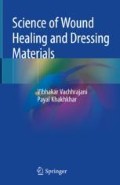Abstract
Since so many years people have been trying to heal wounds. Ancient people used so many herbal products to heal wounds like ghee, honey, leaves of different trees, wine, milk, lint, etc. Even many herbal preparations are available today with combination of turmeric powder, aloe vera, karanj oil, etc. Nowadays there are so many varieties of dressing materials available. Contaminated and colonized wounds do not require antiseptics and antibiotics, only infected wounds need a use of antibiotics. There are many systemic and local causes for non healing of a wound. Proteinases, cytokines and growth factors have a significant role in the process of healing.
Access this chapter
Tax calculation will be finalised at checkout
Purchases are for personal use only
References
Cohen IK. A brief history of wound healing. Yardley, PA: Oxford Clinical Communication Inc; 1998.
Veves A, et al. Chapter 3: The evolution of wound healing. In: The diabetic foot. 2nd ed. Totowa, NJ: Humana Press; 2006. p. 51.
Dwivedi D, et al. Evaluation of wound healing, anti-microbial and antioxidant potential of Pongamia pinnata in wistar rats. J Tradit Complement Med. 2017;7(1):79–85.
Mahmudi G, et al. The impact of turmeric cream on healing of caesarean scar. West Indian Med J. 2015;64(4):400.
Veves A, et al. Chapter 4: The wound healing process. In: The diabetic foot. 2nd ed. Totowa, NJ: Humana Press; 2006. p. 60.
Sheehan P, Jones P, Caselli A, Giurini J, Veves A. Percentage change in wound area of diabetic foot ulcers over a 4-week period is a robust predictor of complete healing in a 12-week prospective trial. Diabetes Care. 2003;26(6):1879–82.
Steed DL, Attinger C, Colaizzi T, et al. Guidelines for the treatment of diabetic ulcers. Wound Repair Regen. 2006;14:680–92.
Author information
Authors and Affiliations
Rights and permissions
Copyright information
© 2020 Springer Nature Singapore Pte Ltd.
About this chapter
Cite this chapter
Vachhrajani, V., Khakhkhar, P. (2020). Introduction. In: Science of Wound Healing and Dressing Materials. Springer, Singapore. https://doi.org/10.1007/978-981-32-9236-9_1
Download citation
DOI: https://doi.org/10.1007/978-981-32-9236-9_1
Published:
Publisher Name: Springer, Singapore
Print ISBN: 978-981-32-9235-2
Online ISBN: 978-981-32-9236-9
eBook Packages: MedicineMedicine (R0)

